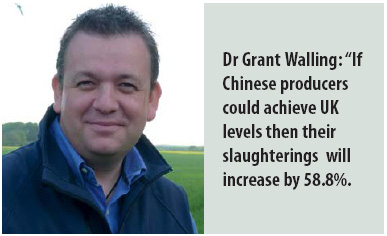Revolutionising global pork production

World pork production will have to grow a lot to meet future demands. Impossible, or doable? Grant Walling, JSR Genetics, thinks current potential reveals the opportunities of the future.
Producing enough food to feed the world in 2050 has been a popular topic of debate of late and Dr Grant Walling, managing director, JSR Genetics put forward his own views with regard to pork production at a recent annual JSR Technical Conference held at the University of Nottingham’s Sutton Bonington Campus.
He discussed hunger to be widespread even in 2011 so feeding an increased global population is a huge problem, coupled with the effects climate change has on farming systems. Walling said that the world population should be getting more efficient at food production but the opposite is the case. In 1940 one calorie of fossil fuel produced 2.3 food calories, whereas in 2008 it required ten fossil fuel calories to produce just one food calorie.
The combined effects of a 28.6% increase in the world population (2050: 9 billion) coupled with an increase in per capita consumption of pork means that the current world pork consumption of 120 million metric tonnes will have more than doubled to 250 million metric tonnes by 2050, a 108.9% increase, Walling stated.
Meeting the challenge
Walling went on to the main question – how does the world pork industry meet this challenge? Improving current productivity would go some way to meeting this target, he said, mentioning some figures. Currently the United Kingdom with 0.43 million sows is slaughtering 22.47 pigs/sow/year, whereas China with her massive 48.5 millions sows only produces 14.15 slaughter pigs/year. If Chinese producers could achieve UK output levels then Chinese slaughterings would be increased by a massive 58.8%. Applying the same maths would boost Brazil’s output by 83.6% and Russia’s by 67.6%. This is significant, Walling said, but it must be remembered that Russia and Brazil’s total sow numbers are only just over 10% of China’s. Boosting China, Brazil and Russia’s output to UK levels would increase the world pork supply by 32.3%.
New technologies
Walling discussed various new technologies. Cloning offers great potential, he said, as it uses proven genetics and can produce ‘tailor-made’ pigs. Taking litter size as an example, cloning could increase UK output by 62.6%.
The science of genetic modification (GM) is most commonly associated with crop production, Walling said, with yields being increased by boosting drought tolerance and resistance to pests and diseases. Naturally boosting pig numbers means a similar boost in crop yields will be needed and with GM wheat 20% more pig meat could be produced per hectare of this cereal.
“Using all these technologies JSR are targeting to farrow 27 pigs/litter with 56 pigs weaned/sow/year by the year 2050,” commented Walling. There are biological limits to uterine capacity and gestation length and stockmanship limits to reducing pre-weaning mortality. In addition, legislative limits regulate weaning age.
He added, “Average carcass weight would double to 167 kg with average daily liveweight gain from weaning to slaughter standing at 1.618 kg/day.” Appetite and stomach capacity have a bearing here along with nutrient intake and feed specifications. He said more piggery accommodation would be needed and slaughter lines would have to be beefed up to take those much heavier carcasses.
Producing vast numbers of very heavy fast growing pigs has welfare implications and Walling suggested that a re-think on how welfare is measured or perceived will be necessary. Currently, welfare standards are perception-based, i.e. keeping a sow in a stall is cruel because humans would consider being kept in a stall as being cruel.Walling would like to see quantitative measures of stress introduced based on the premise that lower stress equals higher welfare and these would include blood cortisol levels, muscle pH post slaughter, white blood cell counts and body temperature.











